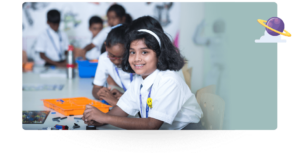10 Aug How Creative Arts Can Transform the Minds of Children In School?

In recent times, art education is under cloud due to political and curriculum pressure. Though the subject of Art and Design is mentioned in the national curriculum, the focus of successive governments at the center and state on math, science, and literacy has led to marginalization of creative arts teaching in schools.
Art educationalists, and psychologists who study children’s art, claim that it promotes educational benefits that other school subjects cannot. These benefits come both from practicing art and from learning about it. This suggests that the continued marginalization of art in schools prevents children from gaining a broad and well-rounded education.
Psychologists and art educationalists who are engaged in studying the children’s art observe that it promotes educational advantages that other school subjects miss out.
Students require a broad education that covers arts as well. More so, the development of our society is subject to creative education. The education of art teaches a particular set of thinking abilities that are not appropriately addressed in the curriculum. Teachers with creative minds encourage and support student creativity in the classroom. Sadly, those who lack creativity do not encourage students to develop creativity.
Pupils can sum up their experiences of the world and exhibit it through art. Besides a creative art program enables forging new connections and relationships through inventive minds, besides building their knowledge and enhancing memories and fantasies.
Let us identify how creative arts can tap the potential of students:
Left brain/ Right brain: There is a common notion that each individual is either left-brained or right-brained. Noticeably, children have varying learning styles. The left brain of a child tends to have a liking for workbooks, whereas the right brain of a child exhibits interest in discussions and prefers projects to text books. A majority of school curriculum teaches in a more left brain style and focus on auditory and sequential features, in addition writing. The right brain children may often feel ignored and even has difficulty in coming to grips with learning and retaining substance using the same curriculum.
According to Dr. Corballi, a professor in the University of Auckland in New Zealand, states – “Creativity is often perceived as right brain functionality and language that is creative, has its place in the left brain for a majority of people”.
In adolescent children, the right brain and its feelings tend to have an upper hand over logic of the left brain.
Expression of feelings/emotions: Making images enables students to express their emotions and ideas, both as tools of self-expression and to communicate with others. These may be recollecting a happy event they recently celebrated (whether it is a birthday party or a day out), or exuding certain sad feelings as a therapeutic exercise.
Sharanya Narayani International School, on its part, identifies and helps children manage the expression of feelings/emotions. It believes emotional abilities should get due weightage in children’s education as much as reading, math, science, and history receive.
Systematic, sustained and concerted action is required to significantly enhance the creative and innovative capacities of young students in ways that are relevant to brighter and confident world. Therefore SNIS find a need to promote the validation of learning outcomes gained in non-formal learning and students work in a vocabulary that is both understandable to educators and students.



Sorry, the comment form is closed at this time.